tire type JEEP CHEROKEE 2017 KL / 5.G Owner's Manual
[x] Cancel search | Manufacturer: JEEP, Model Year: 2017, Model line: CHEROKEE, Model: JEEP CHEROKEE 2017 KL / 5.GPages: 615, PDF Size: 5.72 MB
Page 492 of 615
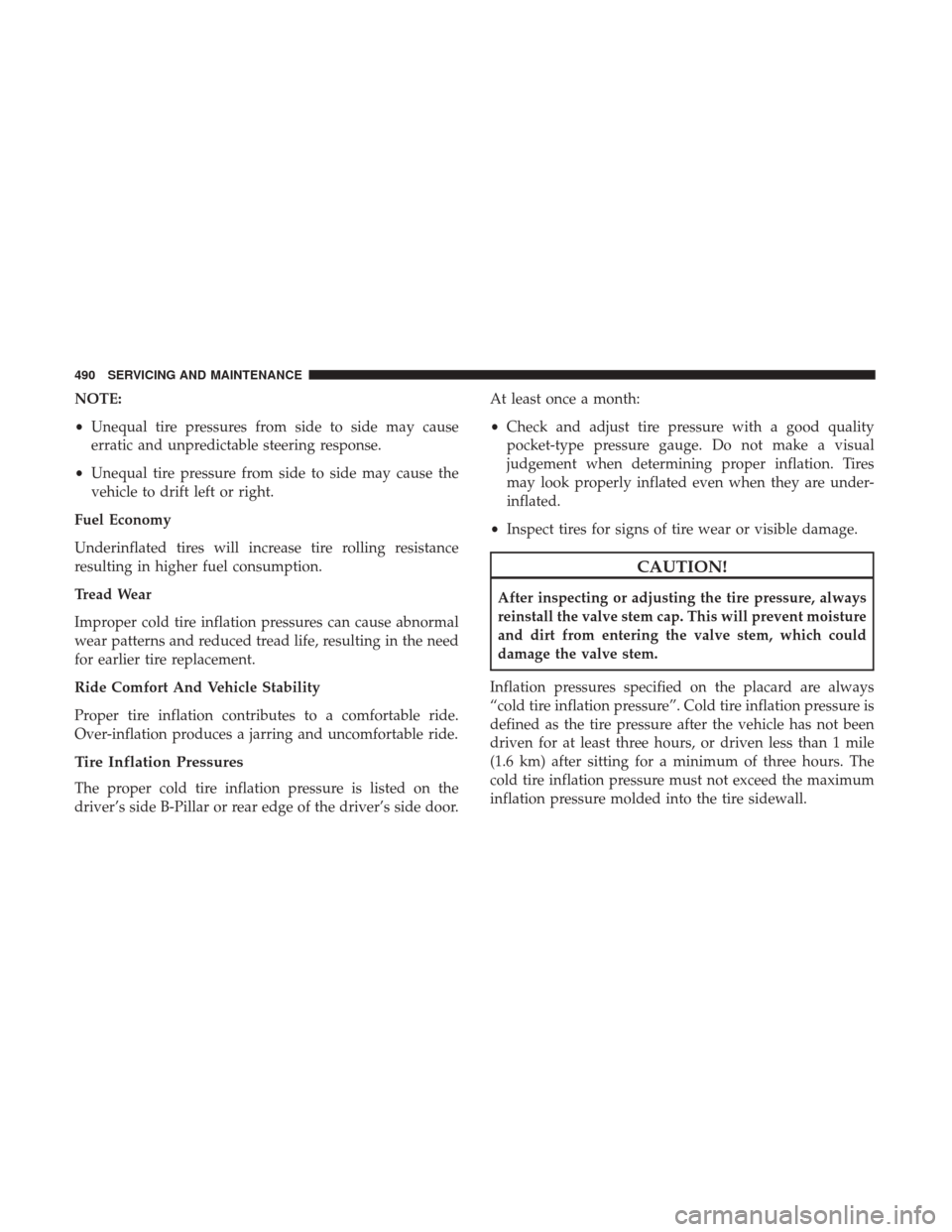
NOTE:
•Unequal tire pressures from side to side may cause
erratic and unpredictable steering response.
• Unequal tire pressure from side to side may cause the
vehicle to drift left or right.
Fuel Economy
Underinflated tires will increase tire rolling resistance
resulting in higher fuel consumption.
Tread Wear
Improper cold tire inflation pressures can cause abnormal
wear patterns and reduced tread life, resulting in the need
for earlier tire replacement.
Ride Comfort And Vehicle Stability
Proper tire inflation contributes to a comfortable ride.
Over-inflation produces a jarring and uncomfortable ride.
Tire Inflation Pressures
The proper cold tire inflation pressure is listed on the
driver’s side B-Pillar or rear edge of the driver’s side door. At least once a month:
•
Check and adjust tire pressure with a good quality
pocket-type pressure gauge. Do not make a visual
judgement when determining proper inflation. Tires
may look properly inflated even when they are under-
inflated.
• Inspect tires for signs of tire wear or visible damage.
CAUTION!
After inspecting or adjusting the tire pressure, always
reinstall the valve stem cap. This will prevent moisture
and dirt from entering the valve stem, which could
damage the valve stem.
Inflation pressures specified on the placard are always
“cold tire inflation pressure”. Cold tire inflation pressure is
defined as the tire pressure after the vehicle has not been
driven for at least three hours, or driven less than 1 mile
(1.6 km) after sitting for a minimum of three hours. The
cold tire inflation pressure must not exceed the maximum
inflation pressure molded into the tire sidewall.
490 SERVICING AND MAINTENANCE
Page 493 of 615
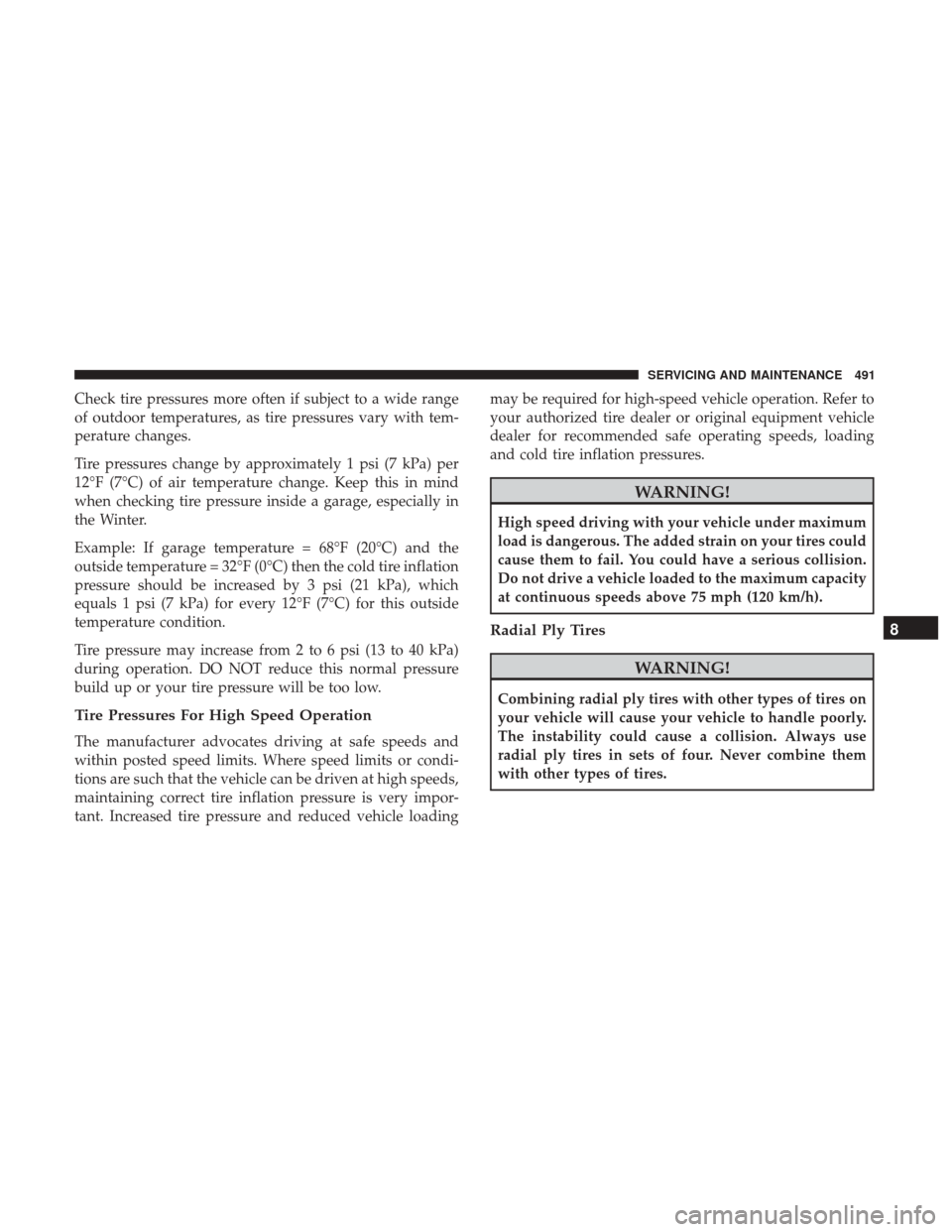
Check tire pressures more often if subject to a wide range
of outdoor temperatures, as tire pressures vary with tem-
perature changes.
Tire pressures change by approximately 1 psi (7 kPa) per
12°F (7°C) of air temperature change. Keep this in mind
when checking tire pressure inside a garage, especially in
the Winter.
Example: If garage temperature = 68°F (20°C) and the
outside temperature = 32°F (0°C) then the cold tire inflation
pressure should be increased by 3 psi (21 kPa), which
equals 1 psi (7 kPa) for every 12°F (7°C) for this outside
temperature condition.
Tire pressure may increase from 2 to 6 psi (13 to 40 kPa)
during operation. DO NOT reduce this normal pressure
build up or your tire pressure will be too low.
Tire Pressures For High Speed Operation
The manufacturer advocates driving at safe speeds and
within posted speed limits. Where speed limits or condi-
tions are such that the vehicle can be driven at high speeds,
maintaining correct tire inflation pressure is very impor-
tant. Increased tire pressure and reduced vehicle loadingmay be required for high-speed vehicle operation. Refer to
your authorized tire dealer or original equipment vehicle
dealer for recommended safe operating speeds, loading
and cold tire inflation pressures.
WARNING!
High speed driving with your vehicle under maximum
load is dangerous. The added strain on your tires could
cause them to fail. You could have a serious collision.
Do not drive a vehicle loaded to the maximum capacity
at continuous speeds above 75 mph (120 km/h).
Radial Ply Tires
WARNING!
Combining radial ply tires with other types of tires on
your vehicle will cause your vehicle to handle poorly.
The instability could cause a collision. Always use
radial ply tires in sets of four. Never combine them
with other types of tires.
8
SERVICING AND MAINTENANCE 491
Page 497 of 615
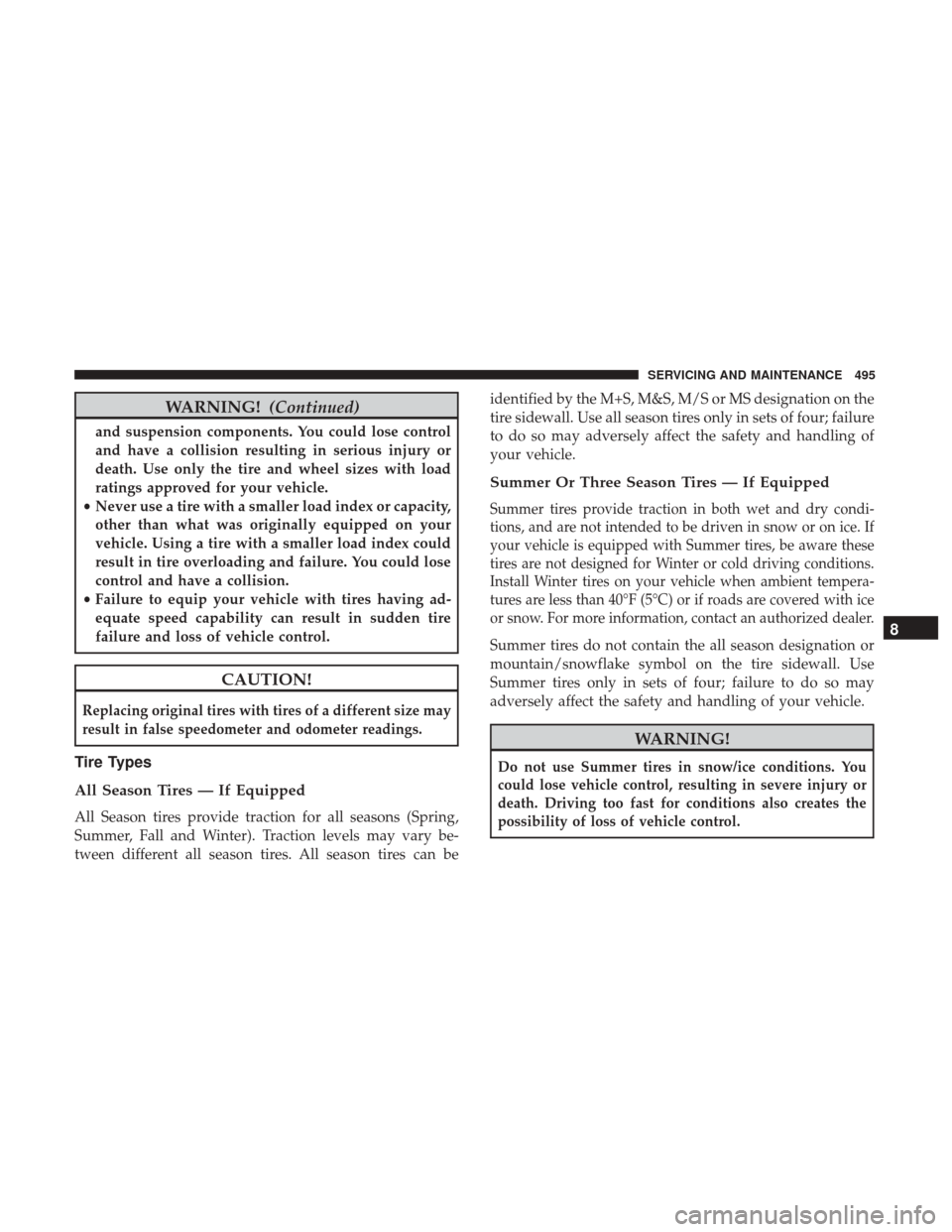
WARNING!(Continued)
and suspension components. You could lose control
and have a collision resulting in serious injury or
death. Use only the tire and wheel sizes with load
ratings approved for your vehicle.
• Never use a tire with a smaller load index or capacity,
other than what was originally equipped on your
vehicle. Using a tire with a smaller load index could
result in tire overloading and failure. You could lose
control and have a collision.
• Failure to equip your vehicle with tires having ad-
equate speed capability can result in sudden tire
failure and loss of vehicle control.
CAUTION!
Replacing original tires with tires of a different size may
result in false speedometer and odometer readings.
Tire Types
All Season Tires — If Equipped
All Season tires provide traction for all seasons (Spring,
Summer, Fall and Winter). Traction levels may vary be-
tween different all season tires. All season tires can be identified by the M+S, M&S, M/S or MS designation on the
tire sidewall. Use all season tires only in sets of four; failure
to do so may adversely affect the safety and handling of
your vehicle.
Summer Or Three Season Tires — If Equipped
Summer tires provide traction in both wet and dry condi-
tions, and are not intended to be driven in snow or on ice. If
your vehicle is equipped with Summer tires, be aware these
tires are not designed for Winter or cold driving conditions.
Install Winter tires on your vehicle when ambient tempera-
tures are less than 40°F (5°C) or if roads are covered with ice
or snow. For more information, contact an authorized dealer.
Summer tires do not contain the all season designation or
mountain/snowflake symbol on the tire sidewall. Use
Summer tires only in sets of four; failure to do so may
adversely affect the safety and handling of your vehicle.
WARNING!
Do not use Summer tires in snow/ice conditions. You
could lose vehicle control, resulting in severe injury or
death. Driving too fast for conditions also creates the
possibility of loss of vehicle control.
8
SERVICING AND MAINTENANCE 495
Page 498 of 615
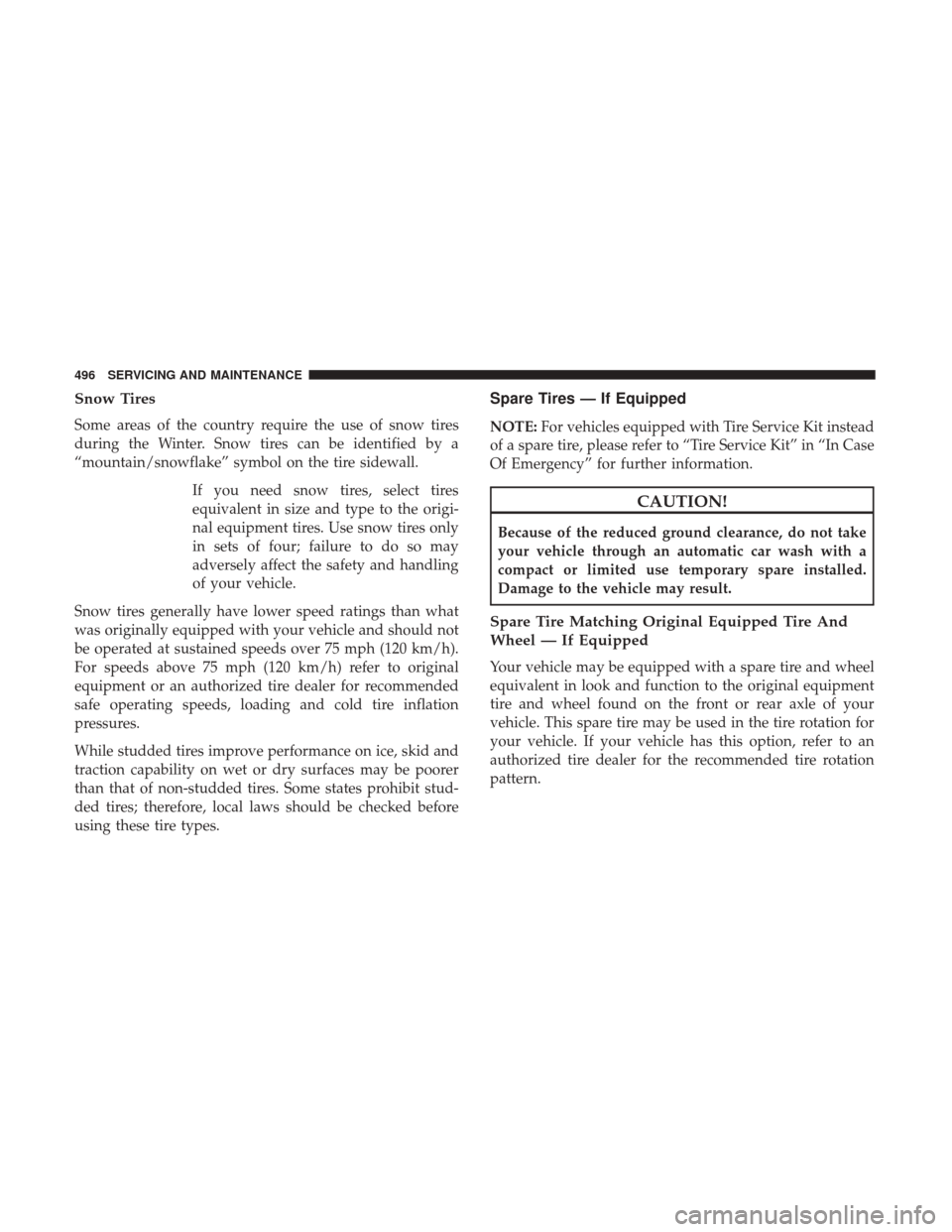
Snow Tires
Some areas of the country require the use of snow tires
during the Winter. Snow tires can be identified by a
“mountain/snowflake” symbol on the tire sidewall.If you need snow tires, select tires
equivalent in size and type to the origi-
nal equipment tires. Use snow tires only
in sets of four; failure to do so may
adversely affect the safety and handling
of your vehicle.
Snow tires generally have lower speed ratings than what
was originally equipped with your vehicle and should not
be operated at sustained speeds over 75 mph (120 km/h).
For speeds above 75 mph (120 km/h) refer to original
equipment or an authorized tire dealer for recommended
safe operating speeds, loading and cold tire inflation
pressures.
While studded tires improve performance on ice, skid and
traction capability on wet or dry surfaces may be poorer
than that of non-studded tires. Some states prohibit stud-
ded tires; therefore, local laws should be checked before
using these tire types.
Spare Tires — If Equipped
NOTE: For vehicles equipped with Tire Service Kit instead
of a spare tire, please refer to “Tire Service Kit” in “In Case
Of Emergency” for further information.
CAUTION!
Because of the reduced ground clearance, do not take
your vehicle through an automatic car wash with a
compact or limited use temporary spare installed.
Damage to the vehicle may result.
Spare Tire Matching Original Equipped Tire And
Wheel — If Equipped
Your vehicle may be equipped with a spare tire and wheel
equivalent in look and function to the original equipment
tire and wheel found on the front or rear axle of your
vehicle. This spare tire may be used in the tire rotation for
your vehicle. If your vehicle has this option, refer to an
authorized tire dealer for the recommended tire rotation
pattern.
496 SERVICING AND MAINTENANCE
Page 503 of 615
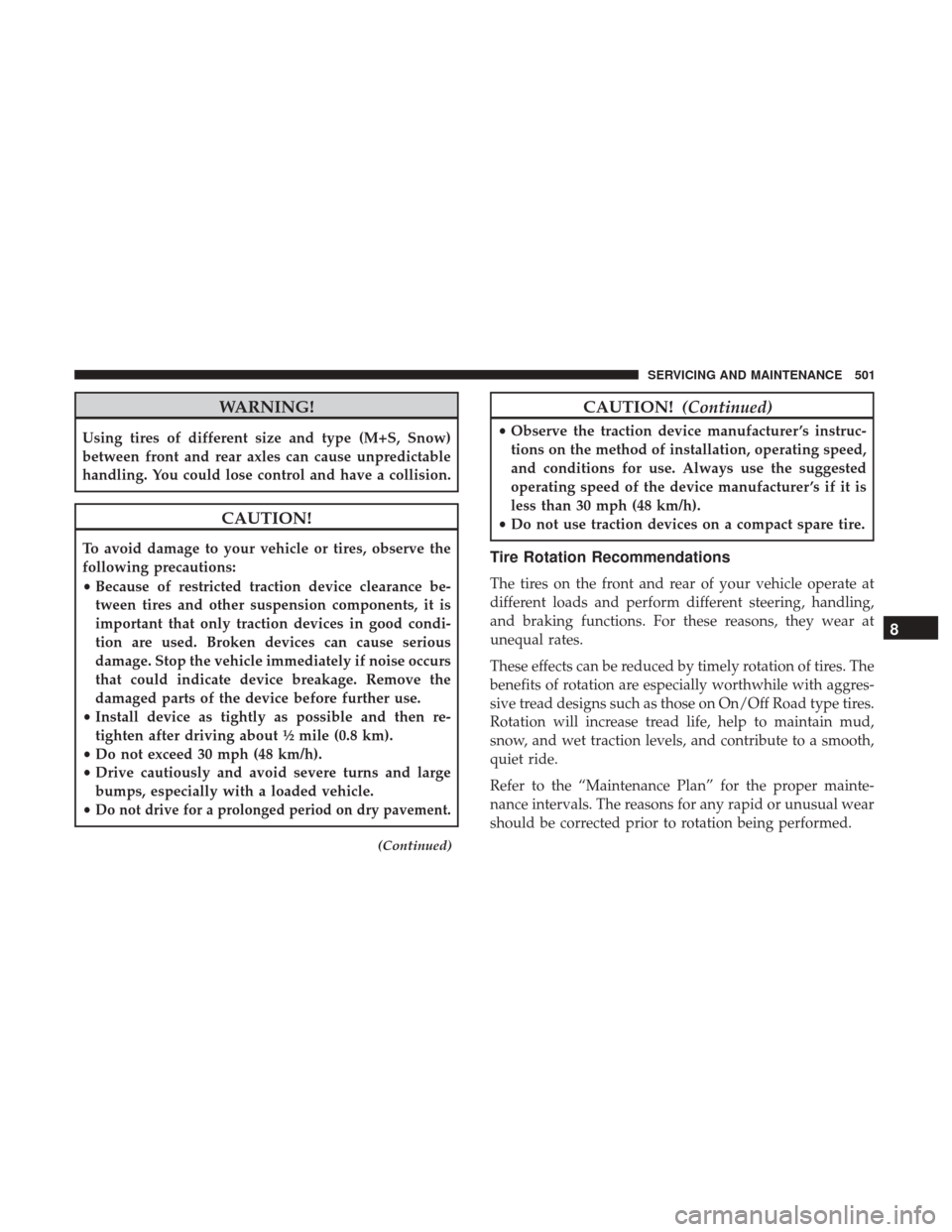
WARNING!
Using tires of different size and type (M+S, Snow)
between front and rear axles can cause unpredictable
handling. You could lose control and have a collision.
CAUTION!
To avoid damage to your vehicle or tires, observe the
following precautions:
•Because of restricted traction device clearance be-
tween tires and other suspension components, it is
important that only traction devices in good condi-
tion are used. Broken devices can cause serious
damage. Stop the vehicle immediately if noise occurs
that could indicate device breakage. Remove the
damaged parts of the device before further use.
• Install device as tightly as possible and then re-
tighten after driving about ½ mile (0.8 km).
• Do not exceed 30 mph (48 km/h).
• Drive cautiously and avoid severe turns and large
bumps, especially with a loaded vehicle.
•
Do not drive for a prolonged period on dry pavement.
(Continued)
CAUTION! (Continued)
•Observe the traction device manufacturer ’s instruc-
tions on the method of installation, operating speed,
and conditions for use. Always use the suggested
operating speed of the device manufacturer ’s if it is
less than 30 mph (48 km/h).
• Do not use traction devices on a compact spare tire.
Tire Rotation Recommendations
The tires on the front and rear of your vehicle operate at
different loads and perform different steering, handling,
and braking functions. For these reasons, they wear at
unequal rates.
These effects can be reduced by timely rotation of tires. The
benefits of rotation are especially worthwhile with aggres-
sive tread designs such as those on On/Off Road type tires.
Rotation will increase tread life, help to maintain mud,
snow, and wet traction levels, and contribute to a smooth,
quiet ride.
Refer to the “Maintenance Plan” for the proper mainte-
nance intervals. The reasons for any rapid or unusual wear
should be corrected prior to rotation being performed.
8
SERVICING AND MAINTENANCE 501
Page 504 of 615
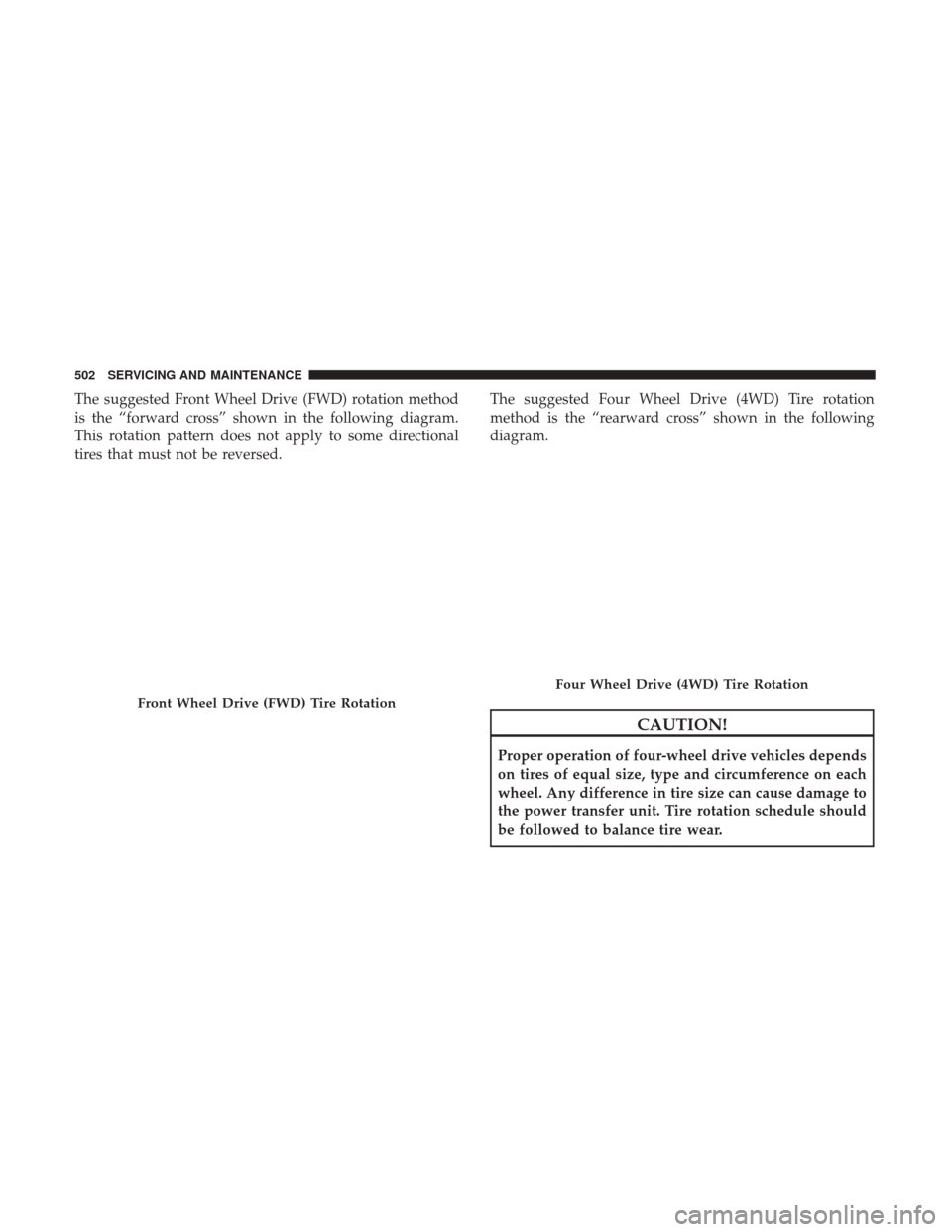
The suggested Front Wheel Drive (FWD) rotation method
is the “forward cross” shown in the following diagram.
This rotation pattern does not apply to some directional
tires that must not be reversed.The suggested Four Wheel Drive (4WD) Tire rotation
method is the “rearward cross” shown in the following
diagram.
CAUTION!
Proper operation of four-wheel drive vehicles depends
on tires of equal size, type and circumference on each
wheel. Any difference in tire size can cause damage to
the power transfer unit. Tire rotation schedule should
be followed to balance tire wear.
Front Wheel Drive (FWD) Tire Rotation
Four Wheel Drive (4WD) Tire Rotation
502 SERVICING AND MAINTENANCE
Page 601 of 615
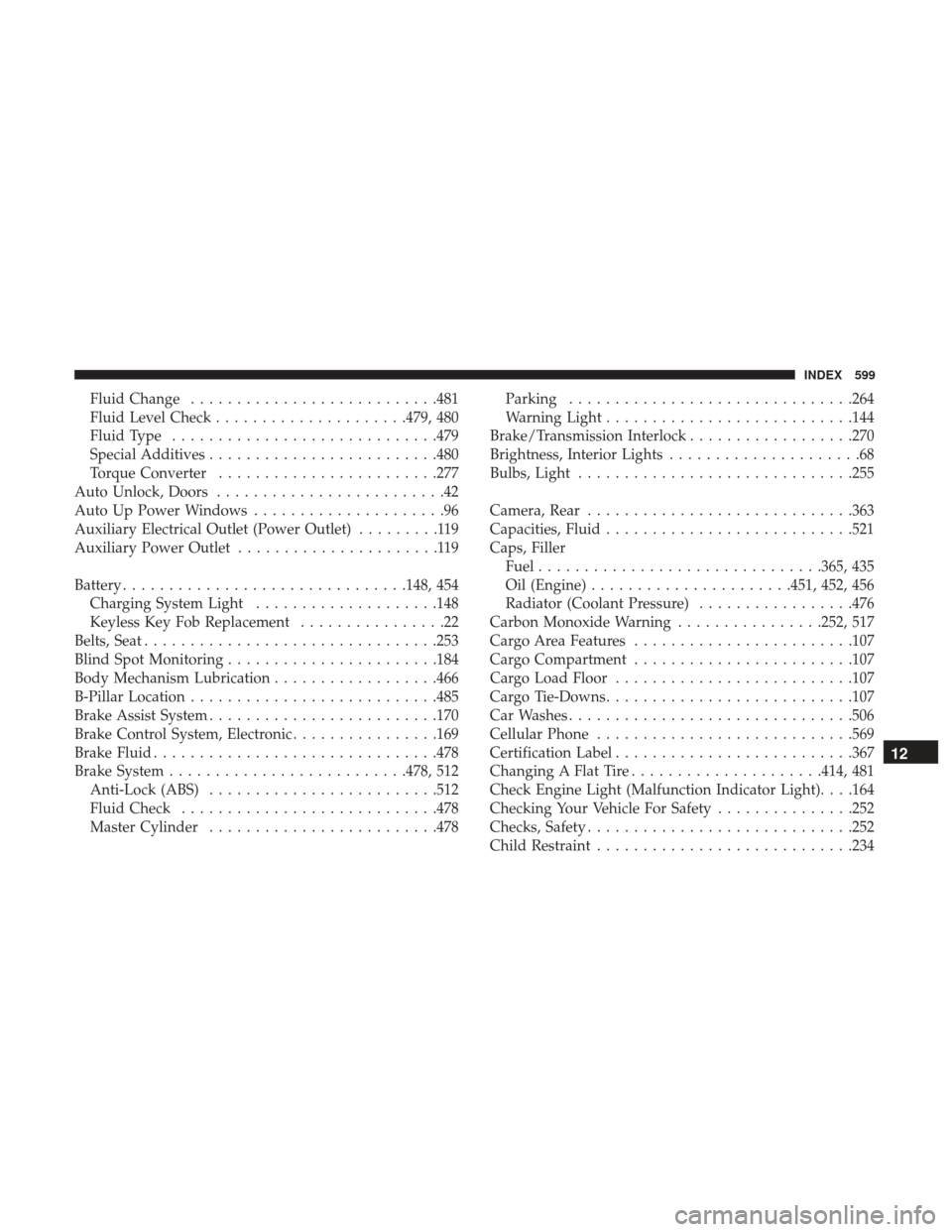
Fluid Change.......................... .481
Fluid Level Check .....................479, 480
Fluid Type ............................ .479
Special Additives ........................ .480
Torque Converter ....................... .277
Auto Unlock, Doors .........................42
Auto Up Power Windows .....................96
Auxiliary Electrical Outlet (Power Outlet) .........119
Auxiliary Power Outlet ......................119
Battery .............................. .148, 454
Charging System Light ....................148
Keyless Key Fob Replacement ................22
Belts, Seat ............................... .253
Blind Spot Monitoring ...................... .184
Body Mechanism Lubrication ..................466
B-Pillar Location .......................... .485
Brake Assist System ........................ .170
Brake Control System, Electronic ................169
Brake Fluid .............................. .478
Brake System ......................... .478, 512
Anti-Lock (ABS) ........................ .512
Fluid Check ........................... .478
Master Cylinder ........................ .478Parking
.............................. .264
Warning Light .......................... .144
Brake/Transmission Interlock ..................270
Brightness, Interior Lights .....................68
Bulbs, Light ............................. .255
Camera, Rear ............................ .363
Capacities, Fluid .......................... .521
Caps, Filler Fuel .............................. .365, 435
Oil (Engine) ..................... .451, 452, 456
Radiator (Coolant Pressure) .................476
Carbon Monoxide Warning ................252, 517
Cargo Area Features ....................... .107
Cargo Compartment ....................... .107
Car
go Load Floor ......................... .107
Cargo Tie-Downs .......................... .107
Car Washes .............................. .506
Cellular Phone ........................... .569
Certification Label ......................... .367
Changing A Flat Tire .....................414, 481
Check Engine Light (Malfunction Indicator Light). . . .164
Checking Your Vehicle For Safety ...............252
Checks, Safety ............................ .252
Child Restraint ........................... .234
12
INDEX 599
Page 609 of 615
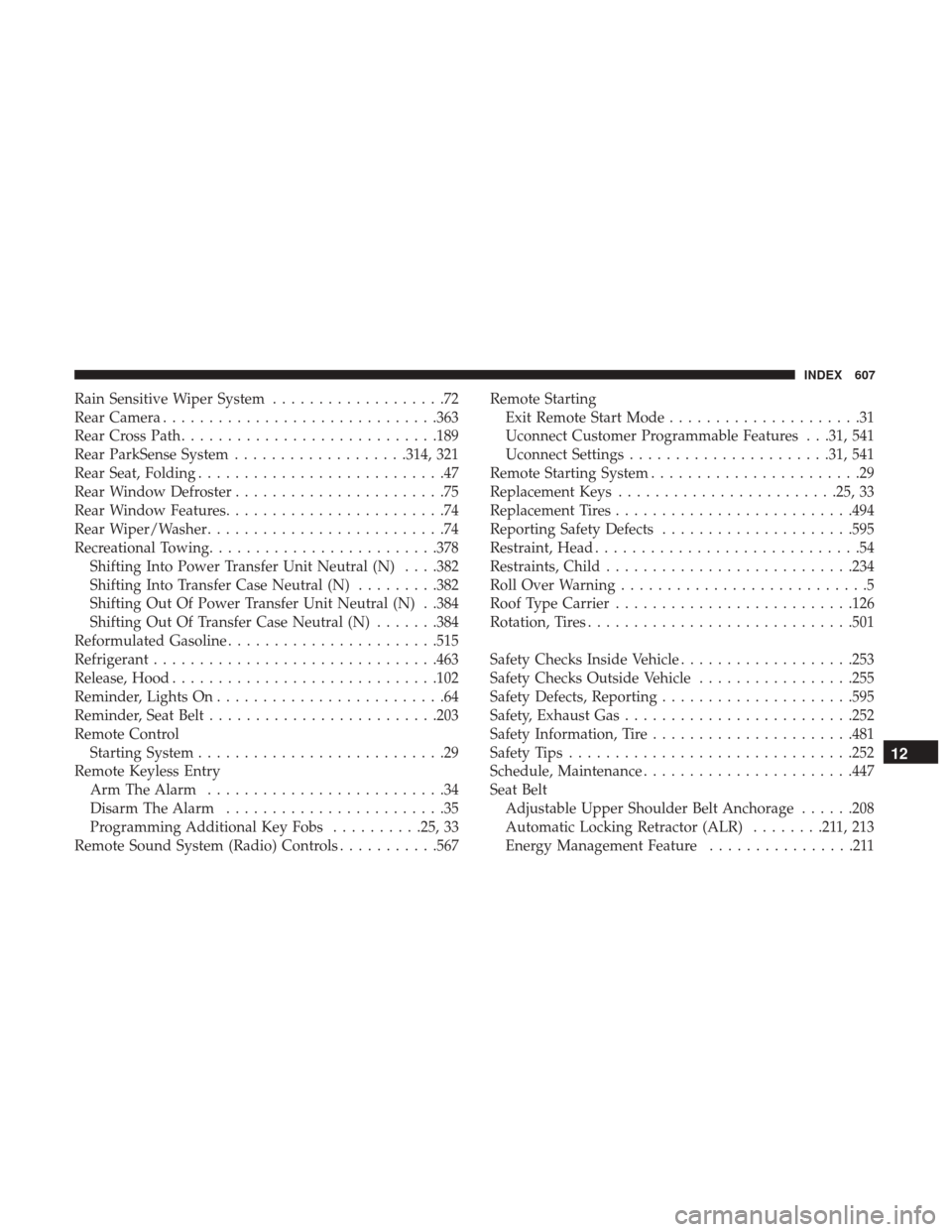
Rain Sensitive Wiper System...................72
Rear Camera ............................. .363
Rear Cross Path ........................... .189
Rear ParkSense System ...................314, 321
Rear Seat, Folding ...........................47
Rear Window Defroster .......................75
Rear Window Features ........................74
Rear Wiper/Washer ..........................74
Recreational Towing ........................ .378
Shifting Into Power Transfer Unit Neutral (N) . . . .382
Shifting Into Transfer Case Neutral (N) .........382
Shifting Out Of Power Transfer Unit Neutral (N) . .384
Shifting Out Of Transfer Case Neutral (N) .......384
Reformulated Gasoline ...................... .515
Refrigerant .............................. .463
Release, Hood ............................ .102
Reminder, Lights On .........................64
Reminder, Seat Belt ........................ .203
Remote Control Starting System ...........................29
Remote Keyless Entry Arm The Alarm ..........................34
Disarm The Alarm ........................35
Programming Additional Key Fobs ..........25, 33
Remote Sound System (Radio) Controls ...........567Remote Starting
Exit Remote Start Mode .....................31
Uconnect Customer Programmable Features . . .31, 541
Uconnect Settings ..................... .31, 541
Remote Starting System .......................29
Replacement Keys ....................... .25, 33
Replacement Tires ......................... .494
Reporting Safety Defects .....................595
Restraint, Head .............................54
Restraints, Child .......................... .234
Roll Over Warning ...........................5
Roof Type Carrier ......................... .126
Rotation, Tires ............................ .501
Safety Checks Inside Vehicle ...................253
Safety Checks Outside Vehicle .................255
Safety Defects, Reporting .....................595
Safety, Exhaust Gas ........................ .252
Safety Information, Tire ..................... .481
Safety
Tips .............................. .252
Schedule, Maintenance ...................... .447
Seat Belt Adjustable Upper Shoulder Belt Anchorage ......208
Automatic Locking Retractor (ALR) ........211,213
Energy Management Feature ................211
12
INDEX 607